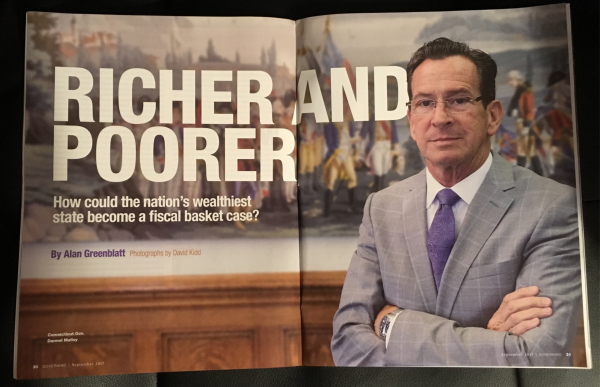State’s Money Woes Earn National Spotlight
/The cover of the national magazine depicts a waterfront home in Mystic Seaport, under the headline that reads “The fiscal mess in America’s richest state.” Connecticut, without an approved state budget for all of July and August and nearly half of September, is earning some notice. And it is not particularly friendly.
The article, in the September issue of Governing, begins with the question, “How could the nation’s wealthiest state become a fiscal basket case?” The answer is complex, and the magazine devotes a full six pages to walking through how the state got into this mess, and how it might navigate its way out.
Along the way, the magazine suggest that the state “may be too rich for its own good,” pointing out that “long blessed with a disproportionate number of high-income residents, the state has entertained lavish spending habits for decades.” It also cites statistics that underscore the problems and challenges:
- Over the past 20 years, job creation numbers have ranked in the bottom five among the 50 states
- Connecticut has the nation’s second-highest rate of income inequality, after New York
- The state has lost population for three years running
- Last year, Greater Hartford ranked fourth and New Haven fifth in population loss among the nation’s 100 largest metro areas
The ineffective state spending cap, approved by voters more than 20 years ago but routinely circumvented since, is cited as a contributor to the fiscal cliff the state sits on, along with an overreliance on the income tax, political infighting, increased taxes, the lack of regionalism and a host of other decisions made by Governors and legislatures for decades.
One glaring example cited: “Connecticut, which is home to 3.6 million people, has 111 police dispatch centers. By comparison, Houston, which as 2.3 million residents, has just one emergency dispatch center, which handles fire as well as police.”
With a circulation of 85,000 in print and a widely viewed website, Governing is described as "the nation's leading media platform covering politics, policy and management for state and local government leaders." It is among the most widely read and most influential among government leaders - with an audience that also includes "journalists, academics, advocates and activists."
 The article did point to some silver linings, past and present. “Connecticut clearly has the means to change course. Not only is its median income still high, but the state boasts assets such as proximity to Boston and New York, amiable coastlines and river valleys, and notable institutions of higher education. In addition to the continuing presence of a thriving financial sector, Connecticut is home to aerospace and defense contractors and other advanced manufacturers who can’t hire help fast enough, as well as a growing medical and life sciences sector.”
The article did point to some silver linings, past and present. “Connecticut clearly has the means to change course. Not only is its median income still high, but the state boasts assets such as proximity to Boston and New York, amiable coastlines and river valleys, and notable institutions of higher education. In addition to the continuing presence of a thriving financial sector, Connecticut is home to aerospace and defense contractors and other advanced manufacturers who can’t hire help fast enough, as well as a growing medical and life sciences sector.”
On the other hand, the publication points out, “Connecticut is 80 percent white, but its population of white children under the age of 10 is falling faster than in any other state. Racial and ethnic minorities already make up more than 50 percent of infants and toddlers and are about to become a majority of 3- and 4-year olds.” There is, the publication adds, “a pronounced achievement gap among racial groups and by geography.”
The conclusion reached by the Governing article? “Connecticut is not in a death spiral but it has failed to position itself to react to changing demographics and location preferences… it’s clear that what’s worked so well for Connecticut in the past isn’t working now.”
Summed up House Speaker Joe Aresimowicz, one of many political leaders, including the Governor and legislators from both political parties, as well as city officials and economic analysts, who were interviewed for the article: “We are the land of steady habits and the world has changed around us.”





























